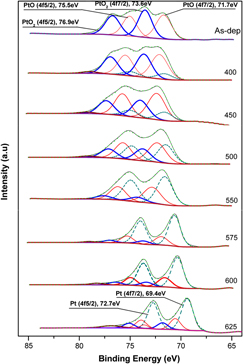Crossref Citations
This article has been cited by the following publications. This list is generated based on data provided by
Crossref.
Ruiz, Esperanza
Cillero, Domingo
Martínez, Pedro J.
Morales, Ángel
Vicente, Gema San
de Diego, Gonzalo
and
Sánchez, José María
2014.
Bench-scale study of electrochemically assisted catalytic CO2 hydrogenation to hydrocarbon fuels on Pt, Ni and Pd films deposited on YSZ.
Journal of CO2 Utilization,
Vol. 8,
Issue. ,
p.
1.
Warwick, Michael E. A.
Kaunisto, Kimmo
Carraro, Giorgio
Gasparotto, Alberto
Maccato, Chiara
and
Barreca, Davide
2015.
A study of Pt/α-Fe2O3 Nanocomposites by XPS.
Surface Science Spectra,
Vol. 22,
Issue. 1,
p.
47.
Warwick, M. E. A.
Barreca, D.
Bontempi, E.
Carraro, G.
Gasparotto, A.
Maccato, C.
Kaunisto, K.
Ruoko, T.-P.
Lemmetyinen, H.
Sada, C.
Gönüllü, Y.
and
Mathur, S.
2015.
Pt-functionalized Fe2O3photoanodes for solar water splitting: the role of hematite nano-organization and the platinum redox state.
Physical Chemistry Chemical Physics,
Vol. 17,
Issue. 19,
p.
12899.
Ruiz, Esperanza
Martínez, Pedro J.
Morales, Ángel
Vicente, Gema San
Diego, Gonzalo de
and
Sánchez, José M.
2016.
Effect of combustion gas components on electrochemically promoted CO 2 capture performance of Pt/K-βAl 2 O 3 at bench scale.
Electrochimica Acta,
Vol. 188,
Issue. ,
p.
184.
Sarker, Subrata
Seo, Hyun Woo
Bakare, Fatai Olawale
Aziz, Md. Abdul
and
Kim, Dong Min
2016.
Facile and rapid preparation of platinum counter electrodes for dye-sensitized solar cells.
Journal of Photochemistry and Photobiology A: Chemistry,
Vol. 321,
Issue. ,
p.
122.
Kang, Wenbo
Zhu, Dongmei
Huang, Zhibin
and
Luo, Fa
2018.
Effects of O2 Partial Pressure on Composition and Infrared Emissivity of PtO
x
Films Prepared by Reactive Magnetron Sputtering.
Journal of Electronic Materials,
Vol. 47,
Issue. 5,
p.
2746.
Sasaki, Hideaki
Matsushita, Haruka
Sakamoto, Keisuke
Sakamoto, Tatsuaki
and
Maeda, Masafumi
2019.
Formation of Pt3O4 particles on PtO2–CeO2 solid solution.
Journal of Physics and Chemistry of Solids,
Vol. 135,
Issue. ,
p.
109097.
Wollny, Patrick
Angel, Steven
Wiggers, Hartmut
Kempf, Andreas M.
and
Wlokas, Irenaeus
2020.
Multiscale Simulation of the Formation of Platinum-Particles on Alumina Nanoparticles in a Spray Flame Experiment.
Fluids,
Vol. 5,
Issue. 4,
p.
201.
Ihnatiuk, Daryna
Tossi, Camilla
Tittonen, Ilkka
and
Linnik, Oksana
2020.
Effect of Synthesis Conditions of Nitrogen and Platinum Co-Doped Titania Films on the Photocatalytic Performance under Simulated Solar Light.
Catalysts,
Vol. 10,
Issue. 9,
p.
1074.
Yi, Feng
Arlington, Shane Q.
Gorham, Justin
Osborn, William
Crumlin, Ethan J.
Nemsak, Slavomir
and
LaVan, David A.
2022.
Growth and Decomposition of Pt Surface Oxides.
The Journal of Physical Chemistry Letters,
Vol. 13,
Issue. 26,
p.
6171.
Lyu, Xianglong
Chen, Jingyuan
Liu, Jiayu
Peng, Yixin
Duan, Shifang
Ma, Xing
and
Wang, Wei
2022.
Reversing a Platinum Micromotor by Introducing Platinum Oxide.
Angewandte Chemie,
Vol. 134,
Issue. 24,
Lyu, Xianglong
Chen, Jingyuan
Liu, Jiayu
Peng, Yixin
Duan, Shifang
Ma, Xing
and
Wang, Wei
2022.
Reversing a Platinum Micromotor by Introducing Platinum Oxide.
Angewandte Chemie International Edition,
Vol. 61,
Issue. 24,
Garapati, Meenakshi Seshadhri
de Prado, Esther
Vretenár, Viliam
Kovářík, Tomáš
and
Němec, Tomáš
2025.
Enhanced Catalytic Activity of Pt Nanostructured Electrodes Deposited by Spark Ablation for Proton Exchange Membrane Fuel Cells.
ACS Applied Materials & Interfaces,
Vol. 17,
Issue. 11,
p.
17295.



